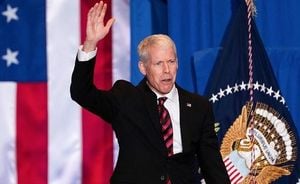On September 24, 2025, former Vice President Al Gore and his nonprofit coalition, Climate TRACE, unveiled a powerful new tool that could change the way the world sees—and responds to—air pollution. By harnessing the power of 300 satellites, 30,000 ground sensors, and state-of-the-art artificial intelligence, Climate TRACE now offers a first-of-its-kind interactive map, tracking the movement and sources of deadly soot and other air pollutants across more than 2,500 cities worldwide.
The announcement, covered by CTV News, CNN, and several other major outlets, marks a major expansion for the Climate TRACE initiative. Originally launched in 2020 to track greenhouse gas emissions, the project has now broadened its scope to include hazardous particulate matter, notably PM2.5—tiny particles that can become lodged deep in the lungs or enter the bloodstream, leading to severe health consequences. According to scientific studies cited by The Associated Press, PM2.5 exposure is responsible for nearly 9 million deaths globally each year, including tens of thousands in the United States alone.
Climate TRACE’s new platform doesn’t just show static numbers. Instead, it visualizes pollution as it drifts through neighborhoods, carried by wind from sources like factories, power plants, ports, and even domestic shipping. Users can zoom in on their own city, or even their own street, and see how pollution plumes move on average days and on worst-case scenario days. Orange dots represent pollution sources; streams of smaller dots trace the path of pollutants as they travel across urban landscapes, shifting with prevailing weather conditions.
“It’s difficult, before AI, for people to really see precisely where this conventional air pollution is coming from,” Gore told The Associated Press. “When it’s over in their homes and in their neighborhoods and when people have a very clear idea of this, then I think they’re empowered with the truth of their situation. My faith tradition has always taught me you will know the truth and the truth shall set you free.”
The scale of the data is staggering. Climate TRACE’s global inventory now includes more than 660 million sources of pollution, but the new soot-tracking system focuses on 137,095 of the most significant particle pollution sources. Of these, 3,937 are classified as “super emitters”—facilities in the top 10% by volume of PM2.5 emissions. According to Climate TRACE’s analysis, about 1.6 billion people live in high-pollution zones worldwide, with over 900 million exposed to air pollution from these super polluters.
Gavin McCormick, cofounder of Climate TRACE and CEO of the environmental tech nonprofit WattTime, emphasized the tool’s impact: “We’ve gone from greenhouse gases to the top seven pollutants of concern for health. In places like the United States, we actually had pretty good data on that already. In most countries, there’s nothing like it, and so that information is the kind of scientific breakthrough here.”
What makes this tool especially groundbreaking is its potential for everyday use. Gore and his coalition hope to integrate the data into popular weather apps, so that, much like checking for rain or pollen, parents of asthmatic children or individuals with heart conditions can see real-time pollution flows in their neighborhood. According to Gore, “Eventually, we will have it on a daily basis, so that if you have a child with asthma or if you have family members with lung and heart conditions that make them sensitive to air pollution, you can go to your favorite weather app and see exactly what the pollution flows have been through your neighborhood that particular day.”
Beyond personal health, the implications are vast for policymakers, researchers, and companies. Health researchers can use the data to study links between pollution and disease at the neighborhood level. Policymakers can make more targeted arguments for regulation, and companies can identify high-polluting sites in their supply chains and transition to cleaner technologies. With the U.S. Environmental Protection Agency moving to reduce some emissions data collection, Climate TRACE aims to fill crucial gaps for scientists and the public alike.
The tool also highlights striking regional disparities. For example, Louisiana’s industrial corridor—known as “Cancer Alley”—has some of the highest pollution levels in the world. Gore explained, “I’ll give you an example. I recently spent a week in Cancer Alley, the stretch between Baton Rouge and New Orleans where the U.S. petrochemical industry is based. That’s a 65-mile (105-kilometer) stretch, you know, and on either side of the river we did an analysis with the Climate TRACE data. If Cancer Alley were a nation, its per capita global warming pollution emissions would rank fourth in the world, behind Turkmenistan.” In Reserve, a community within Cancer Alley, the cancer rate is fifty times the U.S. average.
Globally, the cities with the most people exposed to soot pollution are Karachi, Pakistan; Guangzhou, China; Seoul, South Korea; New York City, USA; and Dhaka, Bangladesh. Only one U.S. metro—New York City—makes the top ten list for population exposed to pollution from major climate change contributors. In Houston, Texas, about 4 million residents are exposed to pollution from nearly 140 industrial facilities. Notably, not all super polluters are power plants or oil refineries; in cities like Boston and Los Angeles, domestic shipping in and out of harbors is a major culprit. “Ships are gnarly for pollution,” McCormick remarked.
For many, the tool transforms an abstract problem into a personal one. McCormick reflected, “My experience with everyone I’ve showed this to is that it feels abstract until they see themselves in the story. You can show people on a map where their house is, they can show you where their kid goes to school, and you can see the pollution. I think that’s just kind of making people realize this is happening to them.”
Al Gore’s vision is that this radical transparency will spur action at every level—from grassroots activists to government leaders. As he told CNN, “My hope is that everyone from grassroots activists to government leaders see these plumes and are equally horrified by the pollution as they are motivated to clean it up and in doing so, address the climate crisis.”
All of Climate TRACE’s emissions tracking data is available for free public download, with the hope that it will empower not just researchers and officials, but also ordinary citizens to demand cleaner air and a healthier future. By connecting the dots between fossil fuel combustion, air pollution, and health, the initiative aims to make the invisible visible—and, perhaps, inspire the change the world so urgently needs.





